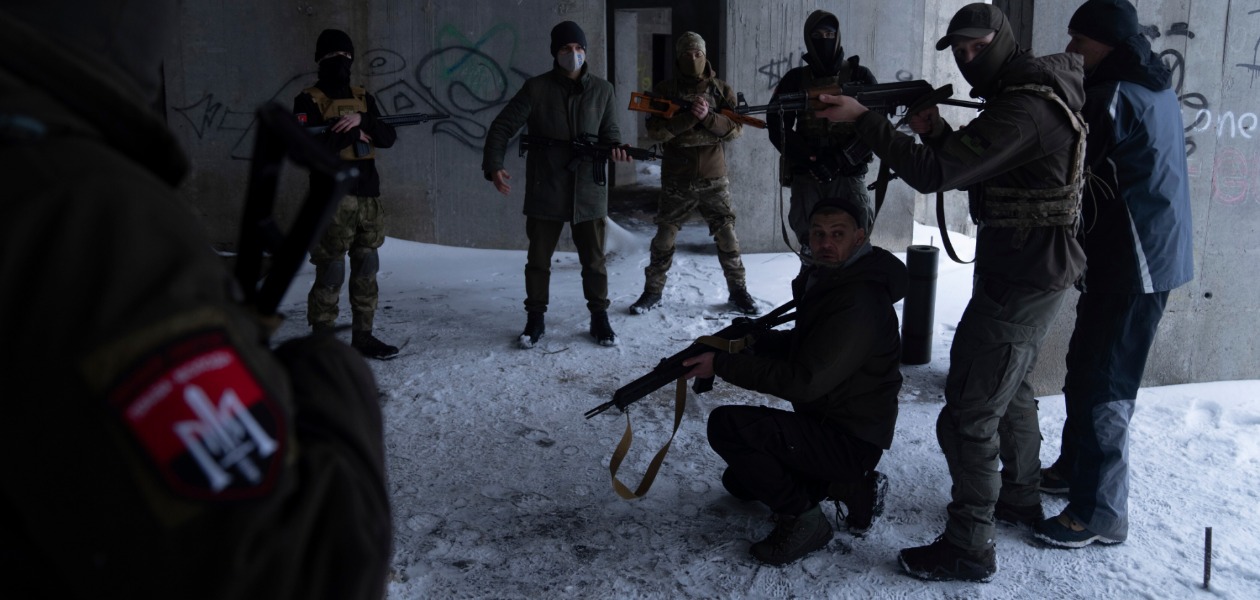
Despite the optimistic talk in the mainstream media of Ukraine steadfastly holding out against the invading forces of President Vladimir Putin and claims that the Russian offensive has become bogged down, the reality is that Washington already expects the Ukrainian government to eventually fall.
And dusting off a proxy war strategy from the 1980s, the U.S is planning to direct a long-term insurgency fight in Ukraine modeled on the CIA’s Cold War clandestine interference in Afghanistan. That imperialist action fueled a deadly civil war and empowered the forces behind the 9/11 terrorist attacks.
This time, it would mean raiding public coffers in the U.S. to arm a hodge-podge army that includes not just well-intentioned Ukrainians struggling to defend their homeland but also neo-Nazi elements fighting a war for ethnic cleansing—all via cash funneled through the major weapons manufacturers of the military-industrial complex.

The massive $1.5 trillion spending package passed with overwhelming support from both Republicans and Democrats Wednesday night includes a down payment for the anticipated guerilla war against Russia. Nearly $14 billion, split evenly between humanitarian relief and weaponry, was set aside for Ukraine—on top of the more than $3 billion in military aid sent since 2014. Another $3 billion was earmarked for the deployment of additional U.S. troops to eastern Europe.
Trying to avoid undermining authorities in Kiev publicly, however, Western countries led by the U.S. are working behind the scenes to prepare a government-in-exile that can serve as a figurehead high command for an insurgency against occupying Russian troops.
According to information reported in The Washington Post, the U.S. State Department and the Pentagon are hurriedly planning for what comes next after the demise of Ukrainian President Volodymyr Zelensky’s government. Currently, the U.S. apparently anticipates the Ukrainian state to be reconfigured as an apparatus operating in another country, most likely Poland.
An anonymous Biden administration official said, “We’re doing contingency planning for every possibility.” American and European diplomats are putting in place the legalistic framework for such a government-in-exile to gain international recognition, starting with a United Nations resolution condemning Russia’s invasion, which passed in the General Assembly last week with 141 votes.
While the Biden administration prefers so far to keep talk of a post-Zelensky Ukraine under wraps, former Secretary of State Hillary Clinton broadcast the threat of a long, bloody insurgency right out in the open in a televised interview on MSNBC recently.
“Remember, the Russians invaded Afghanistan back in 1980,” Clinton said. “It didn’t end well for the Russians…but the fact is that a very motivated, and then funded, and armed insurgency basically drove the Russians out of Afghanistan.”

Another Afghanistan
Clinton was referring to the armed guerilla campaign carried out by mujahideen groups—Islamist fundamentalist fighters—against the socialist government of Afghanistan. In late 1979, Afghan authorities requested military assistance from the neighboring Soviet Union to combat a rural-based religious insurgency that was supported by the U.S., Pakistan, and other anti-communist governments.
The U.S., determined to “give the USSR its own Vietnam war,” coordinated the funding and arming of Islamist rebels in Afghanistan. The clandestine CIA program, known as “Operation Cyclone,” cost the American people at least $3 billion between 1979 and 1992. The goal was to create a protracted war to drain the Soviet economy of resources, create domestic discontent among the peoples of the USSR, and inflame public opinion against communists and socialists across the Muslim world.
To achieve its Cold War objectives, the U.S. allied itself with the mujahideen forces, providing them state-of-the-art anti-aircraft Stinger missiles and other advanced weaponry—all of which exacted deadly costs on Soviet and Afghan troops. The U.S. ignored warnings from allies that, in pursuit of its anti-Soviet mission, it could be creating even bigger problems. In the late 1980s, Benazir Bhutto, prime minister of Pakistan, told President George H.W. Bush, “You are creating a Frankenstein.”
Eventually, in 1989, the USSR withdrew from Afghanistan. The socialist government survived a little longer, finally succumbing to the U.S.-backed rebels in 1992. More than 15,000 Soviet troops were killed in the fighting, while over a million Afghans lost their lives.
Out of the scattered mujahideen groups arose the Taliban, the brutal outfit that imposed a reactionary theocratic regime on Afghanistan from 1995 to 2001. The Taliban, in turn, provided refuge to Osama bin Laden and al Qaeda—the terrorists behind the Sept. 11th attacks in New York and Washington.
It was a textbook case of blowback—imperialist misadventures overseas eventually resulted in direct attacks on America itself and then the U.S.’ own 20-year Afghanistan war. The U.S. occupation of the country finally ended last year, with the Taliban returning to power once more.
In bragging last week about the costs that the mujahideen insurgency inflicted on “the Russians,” Clinton didn’t mention that Operation Cyclone helped create the Taliban and al Qaeda or that it left Afghanistan a war-torn wasteland. The closest she came was admitting, “There were some unintended consequences, as we all know.”
U.S. in Ukraine for the long haul
A Congressional delegation led by Reps. Michael Waltz, R-Fla., and Seth Moulton, D-Mass., met with Ukrainian special operations commanders before the Russian invasion, in December, to assess the weapons and support required to carry out a long-term guerilla campaign.
The Ukrainians were reportedly frustrated at the time that the U.S. had not yet sent advanced Harpoon missiles to strike Russian ships or Stinger missiles to shoot down Russian aircraft. The latter were used against Soviet helicopters to great effect by the mujahideen in the 1980s.
Shortly after that meeting, some weapons that had been intended for the fight against the Taliban in Afghanistan were rerouted to Ukraine instead. Small arms and roadside bombs were among the shipment. It’s anticipated they will be deployed to sabotage Russian food, fuel, and ammunition supply lines. Waltz told the Post, “That’s how you starve the Russian army.”
Even before that Congressional visit, though, the Biden administration had already approved the shipment of Stingers, Javelin missiles, shoulder-launched rockets, grenade launchers, and other weapons to Ukraine, according to a leaked document.
Such sophisticated weaponry will require training by U.S. specialists, however, signaling more direct U.S. involvement in the conflict, even if not on Ukrainian territory.

Moulton, who was a Marine infantry officer during the U.S. occupation of Iraq, said of the weapons, “You can’t ship them to Ukraine at the last minute and expect some national guardsman to pick up a Stinger and shoot down an aircraft.” Guerillas and saboteurs will need guidance and direction.
President Joe Biden continues to say that the U.S. will not join the combat on the ground in Ukraine. But some anonymous officials have expressed concern about U.S. soldiers training Ukrainian insurgents on the territory of a NATO member country like Poland. When those insurgents launch attacks on Russian troops, there is the worry that Russia could view it as a NATO attack.
That is just one possibility in which a U.S.-directed or supported Ukrainian insurgency campaign could spiral out of control and lead to unintended consequences. Given the diversity of right-wing groups that are integrated into the Ukrainian military, the U.S. could also end up providing more deadly training to murderous neo-Nazi and fascist elements determined to escalate the war.
With the nuclear-armed U.S. and nuclear-armed Russia engaged in fighting so close to one another, any wrong move or misperception could result in devastation for the entire world. The risk is great.
Though the mujahideen strategy may have been formulated during the Cold War as part of an anti-communist offensive against the USSR, the plans currently unfolding show that it has been easily reconfigured as a means of targeting any force that tests the limits of global U.S. military hegemony—including the aggressive and nationalistic government of Vladimir Putin.
For the survival of Ukraine—and the world—Russia should immediately cease its offensive operations. It, along with Ukrainian officials, NATO, and the U.S., must commit to de-escalation and negotiation. A protracted war will benefit no one but the weapons manufacturers and other war profiteers.












Comments